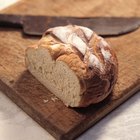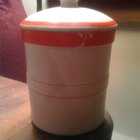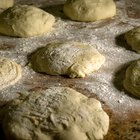
Yeast is a living organism and working with it is possibly the most intimidating thing about bread baking. It helps to keep in mind that yeast prefers the same temperatures that you do, and needs food to stay alive. If your yeast dies during your bread making process, what happens to the dough depends on what stage you are in and the conditions that caused the yeast to die.
Traditional Proofing
The first step in most bread recipes is the activation of the yeast. Warm water is placed in a bowl to which sugar might be added to give the yeast fast food. Live yeast will begin to bubble and react within 5 to 10 minutes. Dead yeast will not produce any bubbles at all, and the liquid will appear stagnant. If your yeast dies at this point in the baking process, your dough will not rise no matter what else you do to it. Throw out the mixture, get new yeast and start again.
Rising Pizza Dough
Some recipes don’t require an initial proofing due to the dependability of commercial yeast packets. This is most common in pizza dough recipes, where the yeast is combined with flour, salt and sugar before mixing with the warm water. When mixing your dough this way, you won’t be able to tell whether you have live yeast until after the first rising. If your yeast is dead, the dough will not rise or change in volume because the yeast won’t be producing air bubbles. If you move your dough to a warmer spot and the yeast is dead, your dough will still remain lifeless. You might also notice cracks on the outer surface of the dough as it dries up from the warm air.
During Additional Risings
The number of yeast cells multiply as they digest the sugars released by the starch. At 104 F, yeast growth begins to slow; at 120 F, yeast begins to die, though some cells might still survive in healthy dough. Once your dough reaches a temperature of 80 F, more lactic acid will accumulate in the dough, giving your bread a buttery flavor with a bigger crumb and crunchy crust. If the yeast begins to die after the first rising of your dough due to high heat, it will not produce the final burst of carbon dioxide; instead, the dough will set. Punching it down and shaping into loaves will produce a flatbread with good flavor, but the dough will not rise during baking like a traditional loaf.
Adding Flavor to the Dough
If your bread dough doesn’t initially rise, there could be other contributing factors besides dead yeast. If the temperature is too cold, your yeast will be put to sleep, so to speak, and cease production of air bubbles. Meanwhile, the flavors of your dough will have a chance to bloom and develop. Many bakers refrigerate dough during the first rise to produce more flavorful bread. To “wake up” your yeast, move it to a spot where the temperature is between 95 to 115 degrees Fahrenheit.
Related Articles

Can You Refrigerate Homemade Yeast ...

Does Heat Kill Lactobacillus Bacteria ...

Can I Substitute Bleached for ...

What if You Forget & Let Bread Dough ...

What Happens When Vinegar & Yeast Are ...

How to Make a Bread Starter

How to Grow Bread Yeast

Can You Substitute Yogurt for Milk in ...

How Does a Bread Maker Work?

Does Yeast Cause Holes in Bread?

Why Bread Dough Does Not Rise

Can You Proof Yeast in Warm Milk?

Why Does Bread Drop in the Middle When ...

How to Use a Bread Machine to Make Dough

How to Make Bread With Ancient Grains

What Happens if You Leave Bread Dough ...

Can You Get Sick From Baking Bread With ...

A List of Leavening Agents

Does Yeast Turn Juice to Alcohol?

Can You Bake Something Half Way & Then ...
References
Writer Bio
For more than 10 years, Carol Butler has run a small, off-grid furniture business with her husband and is a regular contributor to the Edible community of magazines. As staff writer for RichLife Advisors, she covers financial planning and other industry-related topics. She holds a B.F.A. in theater arts.
Photo Credits
Steve Baccon/Photodisc/Getty Images